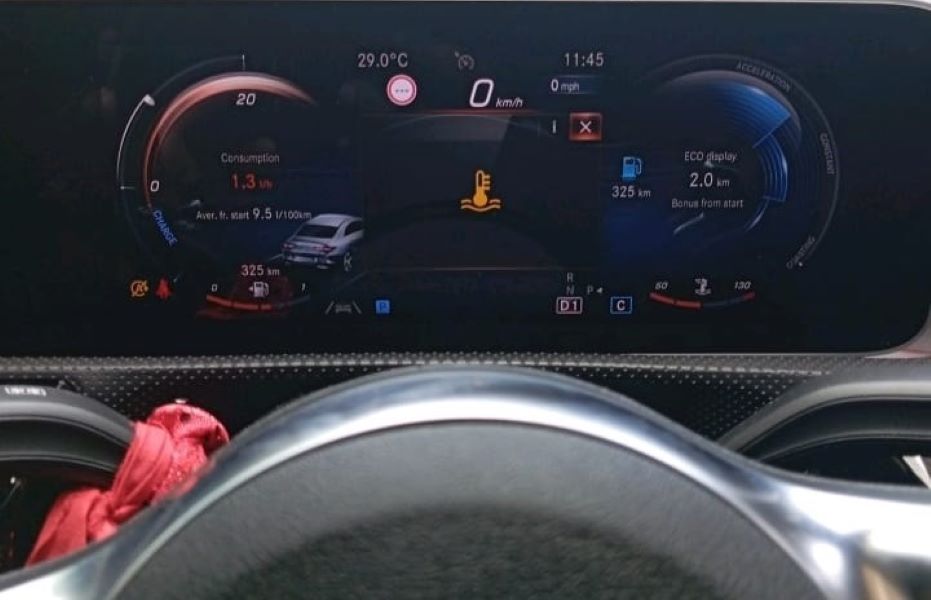Table of Contents
Coolant Light Issue in Mercedes-Benz CLA W118: A Complete Diagnosis & Repair Guide
The coolant warning light is one of the most critical alerts in any modern vehicle. While many drivers associate this light with overheating or low coolant levels, the truth is that it can be triggered by several other issues within the cooling system.
In this case study, we’ll explore a real-world repair on a Mercedes-Benz CLA W118 equipped with the M282 Engine, where the coolant light illuminated despite the engine not overheating. We’ll walk through the diagnostic steps, the root cause, and how the problem was resolved.
If you’re dealing with a coolant light on your dashboard but notice no signs of overheating, this guide will help you understand what’s happening and what steps to take.

Symptoms, Causes, and Fixes
| Symptoms | Possible Causes | Recommended Fix |
|---|---|---|
| Coolant light on (yellow warning) | Faulty radiator shutter or active aerodynamics fault | Inspect and replace defective radiator shutter |
| Warning appears but no overheating | Fault code in cooling system control unit | Run diagnostic scan (Xentry/STAR) to identify fault |
| Shutter not responding to activation | Electrical or mechanical shutter failure | Test power supply, replace faulty shutter |
| Warning disappears after restart | Intermittent shutter malfunction or wiring issue | Check wiring harness and connections |
| Fan running abnormally | ECU trying to compensate for lack of airflow | Restore correct shutter operation via repair/replacement |
Customer Complaint
The customer reported:
- – Coolant light illuminated (yellow) on the dashboard.
- – Vehicle not overheating and performance unaffected.
The technician’s goal was to find out why the light appeared despite the cooling system functioning normally.

Diagnostic Process Using Xentry
Step 1: Fault Code Scan
The first step was connecting the Xentry diagnosis system. The scan revealed:
- – Fault Code: Radiator Shutter Malfunction
- – No additional cooling system errors were logged.
The radiator shutter is part of active aerodynamics, controlling airflow to regulate engine temperature and efficiency.
Step 2: Physical Inspection
- – Technician removed the front bumper for access.
- – No visible damage or debris on the shutter mechanism.

Step 3: Function Test via STAR Diagnosis
- – Attempted to activate the shutter using STAR guided functions.
- – Shutter did not respond to electronic commands → confirmed internal failure.
Step 4: Power Supply Check
- – Voltage test confirmed the shutter was receiving correct power.
- – Wiring and fuses intact.
- – Root cause narrowed down to the shutter itself.

However, the technician attempted to activate the radiator shutter using the guided control functions in the STAR diagnosis system but noticed the shutter was not responding to commands. This indicated an electrical or mechanical fault.
Resolution: Radiator Shutter Replacement
With the diagnosis pointing to a faulty shutter unit, the technician proceeded with replacement.
Replacement Procedure
1. Remove Defective Radiator Shutter
- – Disconnected wiring harness.
- – Unbolted and removed faulty shutter.

2. Install New OEM Radiator Shutter
- – Secured with correct torque settings.
- – Reconnected all wiring and tested functionality.
3. Post-Replacement Testing
- – Activated shutter via STAR → shutter responded correctly.
- – Confirmed coolant light no longer appeared.
- – Monitored engine temp → stable and normal.
Final outcome: Coolant light issue resolved.

Tips for Resolving Coolant Light Issues
- – Always run a diagnostic scan first → avoids unnecessary part replacements.
- – Check wiring and fuses before replacing components.
- – Use OEM parts like genuine Mercedes shutters to ensure reliability.
- – Perform regular cooling system inspections to prevent unexpected faults.
Preventative Maintenance for Cooling Systems
- – Service your cooling system every 2 years or as per Mercedes recommendations.
- – Keep radiators clean from debris and dirt.
- – Update vehicle software (thermal management improvements are sometimes included).
- – Never ignore yellow coolant warnings, even if overheating isn’t present.
Conclusion
This case study on the Mercedes-Benz CLA W118 (M282 engine) shows how the coolant light can be triggered by more than just low coolant levels.
Here, a faulty radiator shutter caused the warning. By using Xentry for diagnosis, verifying the power supply, and confirming the failure, the shutter was replaced successfully.
Key Takeaway: If your coolant light is on but the car isn’t overheating, don’t ignore it. Perform a scan and thorough inspection, as active cooling components like shutters and pumps may be at fault.
More Mercedes Cooling System Resources
Want to explore more causes, symptoms, and repair tips for coolant leaks, overheating, and contamination?
Learn more about Mercedes cooling system faults in our full Cooling System Guide.
FAQs
Q1: Why is my coolant light on if the coolant is full?
Because the issue may come from a faulty sensor, radiator shutter, or active cooling system component, not just coolant levels.
Q2: Can I drive with the coolant light on if the car isn’t overheating?
Short distances may be safe, but continued driving without diagnosis risks hidden cooling system failure.
Q3: What is a radiator shutter in Mercedes cars?
It’s part of active aerodynamics, controlling airflow to improve cooling efficiency and fuel economy.
Q4: How much does it cost to replace a radiator shutter?
Replacement usually costs $500–$900, depending on labor and parts.
Q5: Can I reset the coolant light myself?
No. The light reflects a stored fault code. It must be diagnosed and repaired to prevent recurrence.
Author
Written by: Mercedes Expert
Automotive Technical Trainer & Mercedes-Benz Diagnostic Specialist
With years of hands-on experience repairing and diagnosing Mercedes-Benz vehicles, specializes in case-study-based troubleshooting guides that blend workshop accuracy with educational clarity.
Last Updated: August 2025






Leave a Reply